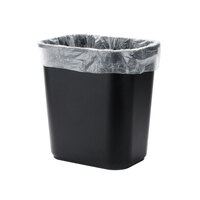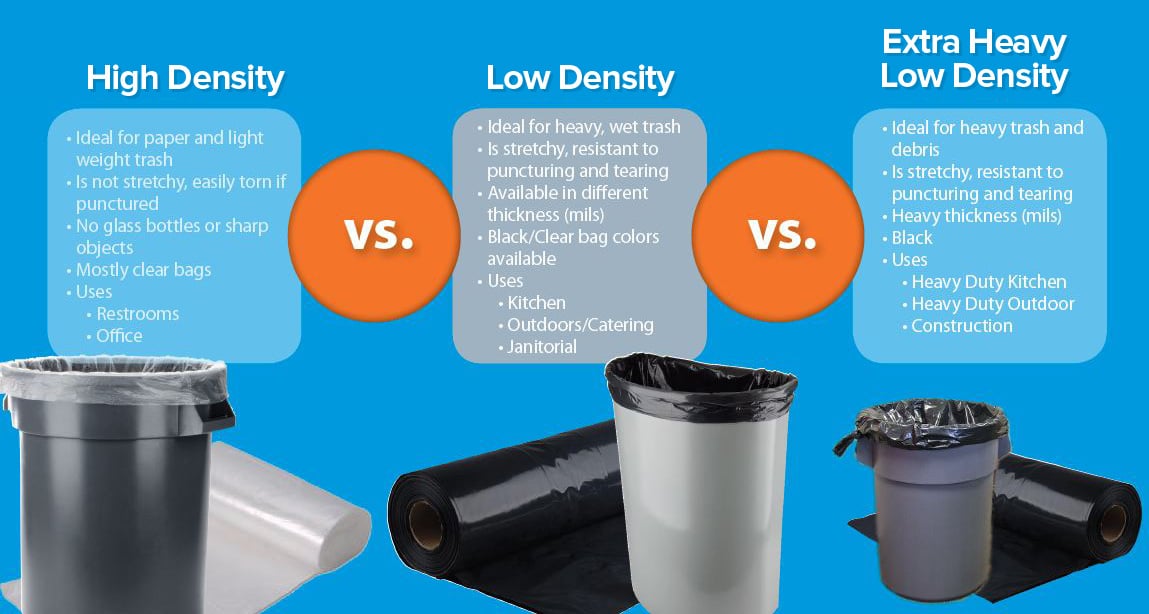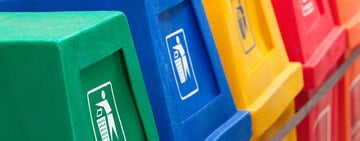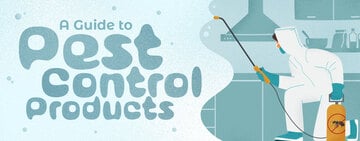
Choosing the Right Trash Can Liner
Trash Bag Thickness

Resin is the basic raw material used in manufacturing trash can liners. The two basic types of resins utilized in trash can liner manufacturing are high density and low density.
- High Density Can Liners: Great for paper and lightweight trash; tears easier if punctured.
- Excellent choice for offices or bathrooms, as long as no sharp or irregularly shaped objects are being discarded.
- Lighter construction means lower freight, storage, and warehousing costs.
- Superior vapor and moisture protection; USDA and FDA approved for food use to help contain unpleasant odors.
- Temperature-resistant from -40 to 212 degrees Fahrenheit.
- Low Density Can Liners: Great for heavy, wet trash; provide exceptional resistance against puncturing and tearing.
- Excellent choice for kitchens, yard waste, and trash with sharp, jagged edges.
- Superior stretch properties make for a great multi-purpose can liner.
- Our Lavex Industrial can liners are contractor level low density can liners, offering the same benefits as low density liners with even greater thickness for yard waste, construction, and demolition use!


Types of Trash Bag Seals
Seal is a term used to describe the bottom of a trash can liner. Seals come in three types: star, flat, and gusset.
- Star Seal: The most common seal in the industry, star seals are manufactured by folding the bottom of the trash can liner over several times and then sealing it. This virtually eliminates leaks, allowing the liner to conform to the shape of the trash can and distribute the refuse evenly around the bag.
- Flat Seal: Manufactured by simply sealing the bottom edge so that no length of the can liner is sacrificed, flat seals provide a generally leak-proof product. They do not, however, conform well to the waste receptacle and can be difficult to handle.
- Gusset Seal: Manufactured with both sides of the bottom edge tucked in to form gussets, gusset seals are reinforced at the indented outer edges with four layers of film while the middle of the bag is sealed with two layers. This causes a tendency to leak with wet trash.



What Size Trash Bag do I Need?
When choosing a trash can liner, consider the following:
Trash Can Liner Size

Trash bags are measured by their length and width when laid flat. Note that the "length" of the liner is the longer edge and the "width" is the shorter. To determine what size bag is needed for your particular waste receptacle:
- Bag Length = Height of your can plus 3" for overhang plus half of the trash can's width (or half the diameter for circular trash cans)
- Example - a circular trash can with a diameter of 24" and height of 30" will be calculated as followed: 30" + 3" + (24"/2) = 45"
- Bag Width = Circumference of your can divided by 2
- Square Container Circumference = Sum of all four sides added together
- Round Container Circumference = Diameter multiplied by 3.14 (or pi, if you channel your middle school math teacher)
- Rectangular Container Circumference = Sum of all four sides added together
Trash Can Liner Use
Will sharp objects or heavy, wet trash be disposed of in these liners?
- If yes, you will want to choose a low density can liner.
- If no, a high density can liner should suit you just fine.

Related Resources

Restaurant Recycling
It is estimated that just one full service restaurant can create over 2,000 pounds of total disposed waste a week. If this fact is alarming to you, perhaps it's time to consider how your food establishment can recycle all that waste. While you may think that the steps to becoming an eco-friendly restaurant are time consuming and costly, you'd be surprised at how easy it is and how much money you can save. Follow the recycling program ideas below to get your restaurant headed in a greener direction. Shop All Recycling Bins What Materials Can Your Restaurant Recycle? Before you begin your restaurant's recycling program, find out what materials your current waste management provider recycles and how they need to be separated. Once you figure o

Pest Control Products Guide
Controlling and eliminating pests is important for all businesses, but it is especially critical in the food service and hospitality industries . The presence of pests is an indicator of uncleanliness and poor hygiene, which will damage your business's reputation. Pests also carry harmful diseases and bacteria that can harm staff and customers, meaning it's vital you take the proper preventative measures to keep your business pest-free . Protect your business with a variety of pest control products, allowing you to combat the threat pests pose to your establishment and even prevent infestations before they can even start. Shop All Pest Control Products Use the following links to Iearn more about different types of pest control products: Rod

Ways to Reduce Food Waste in Your Restaurant
Running a foodservice operation requires a lot of thinking. You have to order ingredients on time, balance your finances, and manage your staff amidst a world of other concerns. As important as it is to consider what food you're making, it's equally important to think about what happens to food that's left uneaten. According to Feeding America , America produces an estimated 72 billion tons of food waste each year. How to Reduce Food Waste in Your Restaurant If you're looking for food waste solutions and how to reduce restaurant food waste in your establishment, follow the steps below to get started: Click any of the tips below to read the section that interests you: Conduct a Food Waste Audit Seek Food Waste Solutions Use Alternative
- Topics 1346
- Industrial 55
- Troubleshooting Guides 21
- Restaurant Management 128
- Bar Management 55
- Catering Tips 35
- Bakery Management 42
- Food Trucks & Concessions 49
- Advertising & Marketing 37
- Eco-Friendly Tips 11
- Facility Layout & Design 41
- Coffee Shop Tips 28
- Installation & Maintenance 51
- Janitorial & Pest Control 30
- Safety & Sanitation 88
- Startup Tips 104
- Menu Design 10
- Kitchen & Cooking Tips 81
- Hospitality Management 23
- Pizza & Sandwich Shop Tips 36
- Smallwares 37
- Food Prep 88
- Tabletop Items 17
- Disposables 22
- Calculators & Tools 6
- Consumables 52
- Warewashing & Laundry 18
- Cooking Equipment 90
- Food Storage & Refrigeration 51
- Beverage Equipment 34
- Office Supplies 6
- Resource Type
- In-Depth Articles272
- Buying Guides296
- How-Tos93
- Product Reviews77



